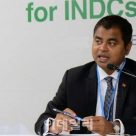
Thoriq Ibrahim
Minister of Environment and Energy
Energy / Maldives
“We hope to have 30% of daily energy demand met by renewables”
As the lowest-lying nation in the world, the Maldives is at the forefront of climate change, a phenomenon that the nation is preparing to battle. The most immediate danger, however, comes not from rising sea levels, but from coastal erosion, which Minister of Environment and Energy Thoriq Ibrahim says is being mitigated through coastal bolder protection and higher land reclamation. We sat down with Minister Ibrahim, who also told us about the nation’s renewable energy ambitions.
What would you say to foreign investors to ensure them that this country is working to combat climate change?
One of the effects of climate change is long-term sea level rise, however it’s a very long-term, gradual occurrence. For us, what is more visible is the change of the dry season, which is getting longer, as well as the occurrence of more gust winds and coastal erosion. Over the last four years, we have protected about 30 kilometers of land in different islands with coastal protection boulders. Moreover, as the chair of AOSIS, we voice out our issues: we know that climate change is man-made and it is due to historic emissions. With the Paris Agreement, there is now a clause that developed countries have to have a minimum contribution of $200 billion by 2020 to mitigate the effects of climate change on smaller developing countries, especially small island-states.
How will Hulhumalé, the nation’s future city, be powered?
To power Hulhumalé, a new 50MW powerhouse is being built that can expand to another 50-100 MW. As of now, it is diesel-generated but it can be changed to a more efficient gas energy system, and we are installing 1.5 MW solar panels on roofs across Hulhumalé through a power purchase agreement. Furthermore, under the China-Maldives Friendship Bridge, we will connect Malé and Hulhumalé together with a high-tension cable, creating the largest connected grid in the country.
How is rapid economic growth being reflected in energy demand?
People are starting to earn more and have been investing in local businesses and guesthouses, so demand for energy is growing. We have 186 inhabited islands with each island’s energy being produced independently via its own generator and grid system. Our challenge is maintaining a reliable supply of energy in a sustainable manner and at cheap rates across 186 mini-grids, despite high electricity generation costs on small islands that lack economy of scale. Moreover, the Maldives is a net importer of energy and spends 15% to 20% of our GDP to meet domestic demand.
What strategy does the government have today to scale up on solar stations?
We have started an ambitious project to provide electricity coming from renewable energy to all 186 islands. Our ambition is to have 30% of daily energy demand met by renewable energy as soon as this year. Over the last four years, we have installed 7MW more of solar energy, and another 4MW are being installed on each of the 186 inhabited islands. We have already studied about 80% of the 186 islands and designs for installation are now being conducted.
What is the biggest challenge you’ve met in your clean energy ambitions?
We have challenges with installing the solar panels because our islands are very small. We don’t have space to have solar panels on land. We have been using roofs, but floating solar stations are one option, too. It is being tested over here, but it is at a very immature state. As a solution, there is no custom duty for materials used to install solar or other renewable energy. We have also come up with regulations on net metering so people can install solar panels on their houses. It’s not very popular, but I’m sure every day solar technology is going to become more and more cost effective and cheaper, with more people using solar power to generate their own power at a household level.
